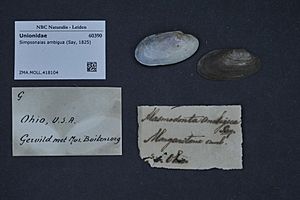Salamander mussel facts for kids
Simpsonaias ambigua, also known as the salamander mussel or mudpuppy mussel, is a special type of bivalve (a mollusc with two shells) that lives in freshwater. It belongs to the Unionidae family, which includes many freshwater mussels.
What makes this mussel truly unique is how its babies grow. Unlike most freshwater mussels that use fish as hosts for their young, the salamander mussel uses mudpuppies! Mudpuppies are a type of salamander that lives in water. This makes Simpsonaias ambigua the only freshwater mussel known to use a non-fish animal as a host for its young.
Quick facts for kids Salamander mussel |
|
|---|---|
 |
|
| Conservation status | |
| Scientific classification | |
| Genus: |
Simpsonaias
|
| Species: |
ambigua
|
| Synonyms | |
|
Simpsoniconcha ambigua (Say, 1825) |
|
Contents
Where Do Salamander Mussels Live?
The salamander mussel is found in parts of the United States and in Ontario, Canada.
Why Are Salamander Mussels Important?
This mussel is very important to protect. In Canada, the salamander mussel is listed as an endangered species. This means there are very few of them left, and they are at high risk of disappearing forever. Protecting them helps keep our freshwater ecosystems healthy.
How Do Salamander Mussels Reproduce?
The way salamander mussels reproduce is fascinating! Like many mussels, they have tiny larvae (baby mussels) called glochidia. These glochidia need to attach to a host animal to grow into juvenile mussels.
For the salamander mussel, this host is the mudpuppy. The glochidia attach to the mudpuppy's gills or skin. They stay there for a short time, getting nutrients and developing safely. Once they are developed enough, they drop off the mudpuppy and start their lives as tiny mussels on the riverbed. This special relationship is vital for the mussel's survival.
See also
 In Spanish: Simpsonaias ambigua para niños
In Spanish: Simpsonaias ambigua para niños


